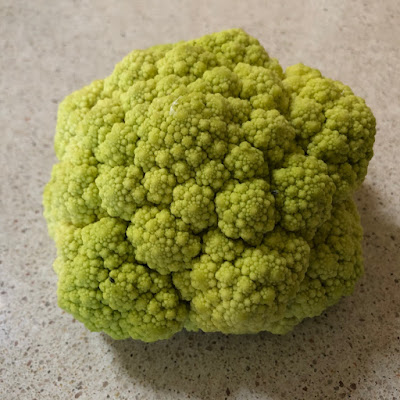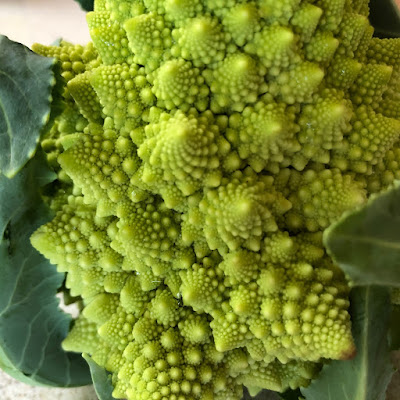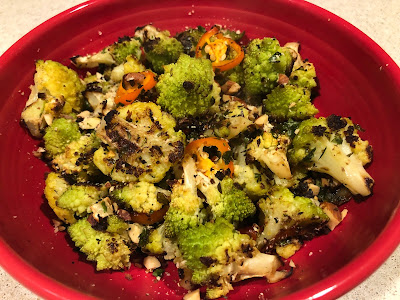
Recipe: Roasted and spiced, this vegetable is a winner

At least this one is green. (Photos: Kathy Morrison) |
I was a latecomer to cauliflower. Too bland, either boiled to death or steamed and left plain -- uh, no thanks. And I can’t eat cheese, so forget about drenching it in gooey sauce.
But roasting was a revelation: Those white florets were suddenly interesting. Wow. Still, the white vegetable in winter, when so much is colorless, can be a turn-off. And the ones in the supermarket are HUGE — my husband and I never finish one head before it begins to deteriorate.
This is all to explain why I was thrilled to find small heads of cauliflower — both white and green — at the farmers market Saturday. They were all 1 pound or less; the already-trimmed green cauliflower weighed just half a pound. I snapped up one of each.
For good measure I added a small head of Roman cauliflower, aka broccoli romanesco or just romanesco, its pointy florets looking like some kind of alien creation.
In fact, this last brassica is so unusual-looking that the prop crew put it in "Star Wars: The Force Awakens," aka Episode 7, as a snack served to Rey at the pirate castle of Maz Kanata. (Yes, bit of a "Star Wars" fan here.) Romanesco has a nutty flavor when cooked.
I was pan-searing ahi tuna for dinner, so chose the two greenish veggies to serve with it. Roasted, spiced and garnished as inspired by a New York Times recipe, they were wonderful.
Try this recipe with any brassica, including broccoli.

It can easily be doubled for one of those big heads of cauliflower. Spice as much or as little as desired.
Roasted cauliflower with spices and almonds
Serves 4 as a side dish
Ingredients:
1 pound florets from cauliflower, broccoli and/or romanesco that have been trimmed and cored
1 tablespoon olive oil
Salt and pepper to taste
1 or 2 garlic cloves, minced
1/2 teaspoon fresh rosemary, minced
1/4 cup chopped fresh parsley
1/8 teaspoon red pepper flakes
Zest from 1/2 lemon
1 to 2 tablespoons almonds, sliced or chopped
1 small red chile or 1/2 of a large one, thinly sliced, for garnish, optional
Lemon juice, for sprinkling after cooking
Instructions:
Heat oven to 425 degrees. Make sure the florets are roughly the same size; slice in half any that are too large. Place the florets in a bowl and toss with the olive oil, and salt and pepper to taste. Scatter them across a shallow roasting pan or baking sheet with a rim. Roast florets 15 minutes.
Meanwhile, mix together in a small bowl the minced garlic, minced parsley, red pepper flakes and lemon zest. When the florets have cooked for 15 minutes, sprinkle the spice mix over them and stir gently, so other sides of the florets will be browned.

Cook for 10 more minutes and test for doneness.
Sprinkle the almonds over the vegetables in the pan. (If using the red pepper slices, you can also add them to the mixture now to barely cook them, if desired.) Cook for up to 5 more minutes, being careful not to burn the almonds.
Place the vegetables in a serving bowl and sprinkle on a bit of fresh lemon juice while they're still hot. Stir and serve.
Comments
0 comments have been posted.Sacramento Digs Gardening to your inbox.
Sites We Like
Garden Checklist for week of July 21
Your garden needs you!
* Keep your vegetable garden watered, mulched and weeded. Water before 8 a.m. to reduce the chance of fungal infection and to conserve moisture.
* Feed vegetable plants bone meal, rock phosphate or other fertilizers high in phosphate to stimulate more blooms and fruiting. (But wait until daily high temperatures drop out of the 100s.)
* Don’t let tomatoes wilt or dry out completely. Give tomatoes a deep watering two to three times a week.
* Harvest vegetables promptly to encourage plants to produce more. Squash especially tends to grow rapidly in hot weather. Keep an eye on zucchini.
* Pinch back chrysanthemums for bushy plants and more flowers in September.
* Remove spent flowers from roses, daylilies and other bloomers as they finish flowering.
* Pinch off blooms from basil so the plant will grow more leaves.
* Cut back lavender after flowering to promote a second bloom.
* It's not too late to add a splash of color. Plant petunias, snapdragons, zinnias and marigolds.
* From seed, plant corn, pumpkins, radishes, winter squash and sunflowers.